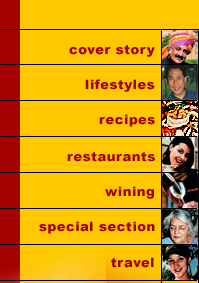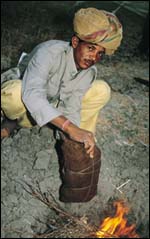


 Khad Cooking, But Without The Game!
Khad Cooking, But Without The Game!
Executive Chef RAJEEV KUMAR of the Umaid Bhavan Palace stages a �cook-out� in the sand dunes of Jodhpur to see whether a leg of lamb cooked the �Khad� way of the erstwhile rulers tastes like fair game. |
|
KHAD cooking... it brings to mind visions of gallant and rugged Rajput Maharajahs crouched over bonfires in which game meat they shot earlier in the jungles of Sawai Madhopur is cooking. While sitting in the warmth of specially-crafted tents that are pitched before the ruins of a fort, or in the protection of a sand dune, and watching this show of royal manliness, are their gracious and beautiful Maharanis.
Traditional bards, dancers and folk singers, all part of the royal retinue, extol in verse and song the legends of Rajasthan that have been relegated to the pages of history. Handmaids spread jasmine essence and rose petals in the hamaams attached to the bathrooms of these tents, for their ladies' evening baths. While stable-hands settle down the exhausted camels and horses that have been used in the shoot and build additional bonfires to keep away the cold... and wild animals of the night.
Later, after the scent of desi ghee rises from the smouldering coals of the khad, announcing that the game dinner is ready, their Royal Highnesses will conclude the day in the true spirit of the shikar. For the moment at least, they will set aside the social etiquette of splendid living and eat heartily using their hands. If game food is to be enjoyed, the first thing to do is to discard the fork and knife.
So, khad cooking was not so much an ancient form of preparing a meal in Rajasthan culinary terms, as it was a royal expression of celebrating life in the great outdoors. Often on a winter evening, I am called upon by some nostalgic member of a Rajasthani royal family to organise a 'cook-out' for them in the sand
dunes of the great Thar desert, or in the craggy hills of Jodhpur, as a reminder of that life.
Of course, these are simple cooking parties, more like picnics meant to impress guests from abroad, and nothing like the elaborate shikars that used to be conducted by their ancestors not so many decades ago. And I use the raan (pinda), or leg of lamb, to demonstrate this wonderfully easy cooking technique. Because the government has banned shikar in Rajasthan, and no more can game like wild boar, deer, and rabbit, be hunted for the pot.
These were hardy meats that could withstand the intense heat generated by khad cooking. More tender flesh, like that of the partridge, pheasant, sand grouse, guinea fowl and wild duck, were treated on a barbecue. My demonstrations of khad cooking help to keep alive one of Rajasthan's most rustic lifestyles and eating habits. And they keep the royal retainers on their toes. For you never know when the government might lift the ban on hunting... and the Maharajahs will ride out on shikar once again!
To prepare a pinda the khad way, I do not need to use any cooking vessels at all, nor any artificial heating methods. A khad (deep pit) is dug into the earth near the royal camp, close enough to spread the warmth of its bonfire, but far away from flecks of burning coal that might burn down the tents. The bottom is filled with coal. Dry twigs and branches of trees are placed in and around it. And cowdung, which is a very good source of fuel, is kept on top of the coal. All that is required now is the fire. And the pinda. In a shikar, it would
depend on how good the hunting of the day was. And any kind of game was good enough for the khad. But I have the pinda.
|

Home Page
About the mag
Subscribe
Advertise
Contact Us